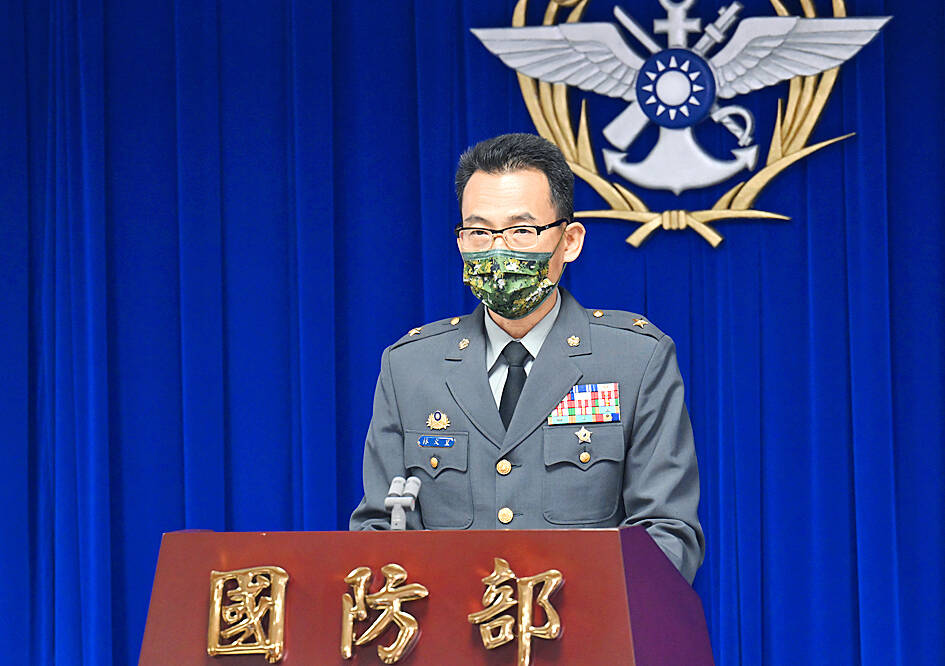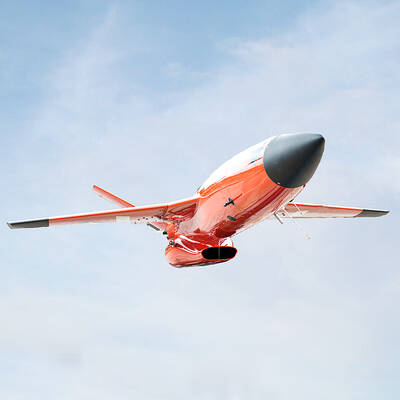A joint Taiwan-US After Action Review team has declared the recently concluded five-day tabletop war game phase of Taiwan’s annual Han Kuang military exercises a success, a senior military official said yesterday.
The team that observed the computerized wargames held from May 15 to 19 has concluded that the defensive force in the simulations was able to achieve all pre-set training goals and is therefore capable of defending itself, Major General Lin Wen-huang (林文皇), who is in charge of planning at the Ministry of National Defense, told a briefing yesterday.
The five-day, around-the-clock war games were conducted using the US-built Joint Theater Level Simulation platform to simulate joint, combined and coalition civil-military operations at the operational level, Lin said.

Photo: Tien Yu-hua, Taipei Times
The simulations are meant to test the ability of military personnel to coordinate and launch a response to a Chinese invasion, Lin said.
A number of potential invasion scenarios were run during the war games based on the latest military threats posed by the Chinese People’s Liberation Army, which recently sent warplanes and warships to surround Taiwan, he added.
What the armed forces learned from these simulations was more important than whether the invaders or defenders ultimately won the war games, he said.
Lin did not disclose who comprised the joint Taiwan-US review team.
A military source previously said that the team consisted of retired US generals and their active-duty Taiwanese counterparts.
The Americans came as observers to provide suggestions on the tabletop war games, which simulated the armed forces’ defensive response to various attack scenarios, the source said, without going into detail.
Similar US teams have made regular visits to Taiwan for the annual exercises in the past, the source said.
The Han Kuang exercises have been held annually since 1984, in the form of live-fire drills and computerized war games, to test Taiwan’s combat readiness in the face of a possible Chinese invasion.
This year marks the 39th edition of the annual exercises, which are Taiwan’s most important military drills and include all branches of the armed forces.
The live-fire exercise component of the exercises is scheduled for July 24 to 28.

‘WIN-WIN’: The Philippines, and central and eastern European countries are important potential drone cooperation partners, Minister of Foreign Affairs Lin Chia-lung said Minister of Foreign Affairs Lin Chia-lung (林佳龍) in an interview published yesterday confirmed that there are joint ventures between Taiwan and Poland in the drone industry. Lin made the remark in an exclusive interview with the Chinese-language Liberty Times (the Taipei Times’ sister paper). The government-backed Taiwan Excellence Drone International Business Opportunities Alliance and the Polish Chamber of Unmanned Systems on Wednesday last week signed a memorandum of understanding in Poland to develop a “non-China” supply chain for drones and work together on key technologies. Asked if Taiwan prioritized Poland among central and eastern European countries in drone collaboration, Lin

The Chien Feng IV (勁蜂, Mighty Hornet) loitering munition is on track to enter flight tests next month in connection with potential adoption by Taiwanese and US armed forces, a government source said yesterday. The kamikaze drone, which boasts a range of 1,000km, debuted at the Taipei Aerospace and Defense Technology Exhibition in September, the official said on condition of anonymity. The Chungshan Institute of Science and Technology and US-based Kratos Defense jointly developed the platform by leveraging the engine and airframe of the latter’s MQM-178 Firejet target drone, they said. The uncrewed aerial vehicle is designed to utilize an artificial intelligence computer

Renewed border fighting between Thailand and Cambodia showed no signs of abating yesterday, leaving hundreds of thousands of displaced people in both countries living in strained conditions as more flooded into temporary shelters. Reporters on the Thai side of the border heard sounds of outgoing, indirect fire yesterday. About 400,000 people have been evacuated from affected areas in Thailand and about 700 schools closed while fighting was ongoing in four border provinces, said Thai Rear Admiral Surasant Kongsiri, a spokesman for the military. Cambodia evacuated more than 127,000 villagers and closed hundreds of schools, the Thai Ministry of Defense said. Thailand’s military announced that

CABINET APPROVAL: People seeking assisted reproduction must be assessed to determine whether they would be adequate parents, the planned changes say Proposed amendments to the Assisted Reproduction Act (人工生殖法) advanced yesterday by the Executive Yuan would grant married lesbian couples and single women access to legal assisted reproductive services. The proposed revisions are “based on the fundamental principle of respecting women’s reproductive autonomy,” Cabinet spokesperson Michelle Lee (李慧芝) quoted Vice Premier Cheng Li-chiun (鄭麗君), who presided over a Cabinet meeting earlier yesterday, as saying at the briefing. The draft amendment would be submitted to the legislature for review. The Ministry of Health and Welfare, which proposed the amendments, said that experts on children’s rights, gender equality, law and medicine attended cross-disciplinary meetings, adding that